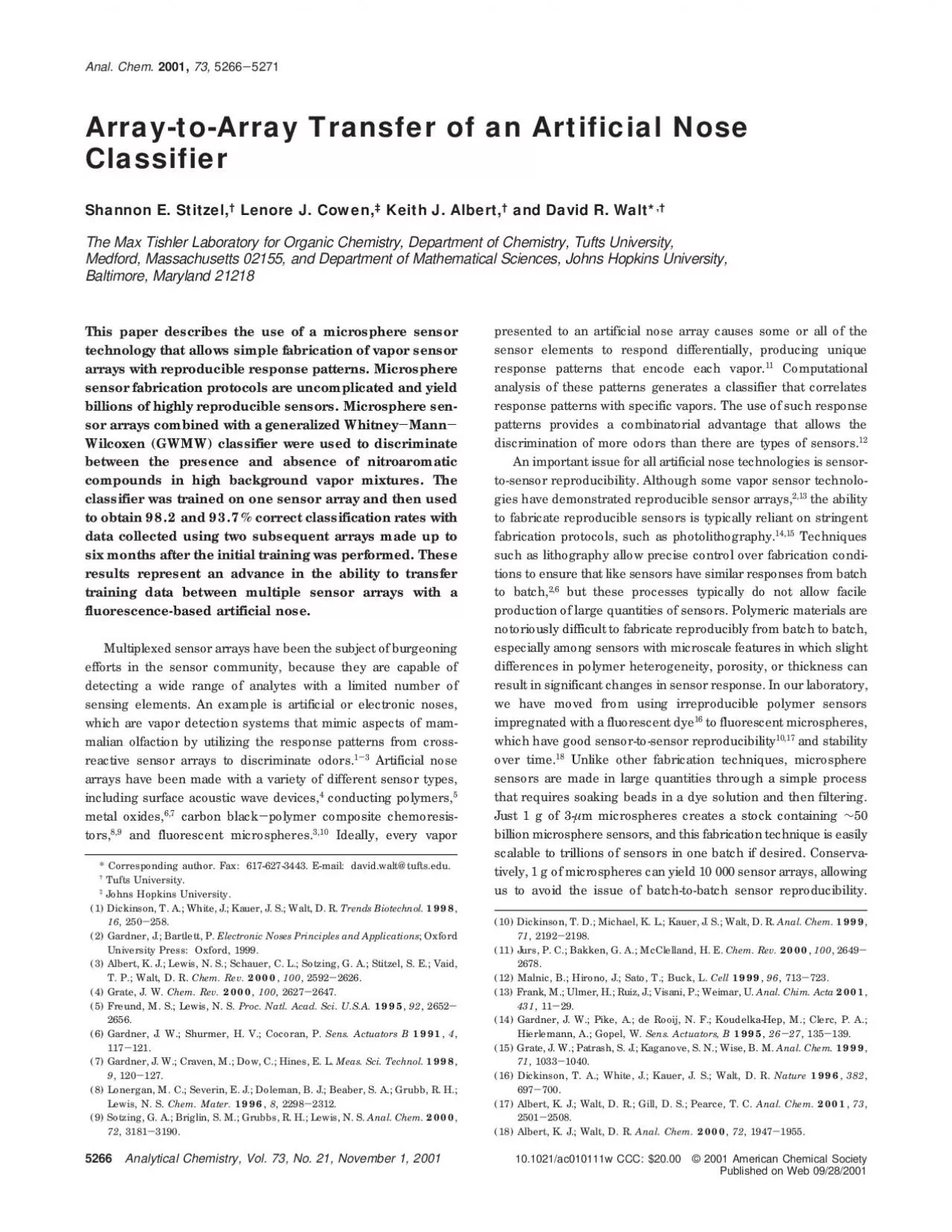

CorrespondingauthorFax6176273443EmaildavidwalttuftseduTuftsUniversityJohnsHopkinsUniversity1DickinsonTAWhiteJKauerJSWaltDRTrendsBiotechnol2502GardnerJBartlettPEl ID: 936587
Download Pdf The PPT/PDF document "ArraytoArrayTransferofanArtificialNoseSh..." is the property of its rightful owner. Permission is granted to download and print the materials on this web site for personal, non-commercial use only, and to display it on your personal computer provided you do not modify the materials and that you retain all copyright notices contained in the materials. By downloading content from our website, you accept the terms of this agreement.
Array-to-ArrayTransferofanArtificialNoseShannonE.Stitzel,LenoreJ.Cowen,KeithJ.Albert,andDavidR.Walt*TheMaxTishlerLaboratoryforOrganicChemistry,DepartmentofChemistry,TuftsUniversity,Medford,Massachusetts02155,andDepartmentofMathematicalSciences,JohnsHopkinsUniversity,Baltimore,Maryland21218Thispaperdescribestheuseofamicrospheresensortechnologythatallowssimplefabricationofvaporsensorarrayswithreproducibleresponsepatterns.Microspheresensorfabricationprotocolsareuncomplicatedandyieldbillionsofhighlyreproduciblesensors.Microspheresen-sorarrayscombinedwithageneralizedWhitneyWilcoxen(GWMW)classifierwereusedtodiscriminatebetweenthepresenceandabsenceofnitroaromaticcompoundsinhighbackgroundvapormixtures.Theclassifierwastrainedononesensorarrayandthenusedtoobtain98.2and93.7%correctclassificationrateswithdatacollectedusingtwosubsequentarraysmadeuptosixmonthsaftertheinitialtrainingwasperformed.Theseresultsrepresentanadvanceintheabilitytotransfertrainingdatabetweenmultiplesensorarrayswithafluorescence-basedartificialnose.Multiplexedsensorarrayshavebeenthesubjectofburgeoningeffortsinthesensorcommunity,becausetheyarecapableofdetectingawiderangeofanalyteswithalimitednumberofsensingelements.Anexampleisartificialorelectronicnoses,whicharevapordetectionsystemsthatmimicaspectsofmam-malianolfactionbyutilizingtheresponsepatternsfromcross-reactivesensorarraystodiscriminateodors.Artificialnosearrayshavebeenmadewithavarietyofdifferentsensortypes,includingsurfaceacousticwavedevices,conductingpolymers,metaloxides,carbonblackpolymercompositechemoresis-andfluorescentmicrospheres.Ideally,everyvaporpresentedtoanartificialnosearraycausessomeorallofthesensorelementstoresponddifferentially,producinguniqueresponsepatternsthatencodeeachvapor.analysisofthesepatternsgeneratesaclassifierthatcorrelatesresponsepatternswithspecificvapors.Theuseofsuchresponsepatternsprovidesacombinatorialadvantagethatallowsthediscriminationofmoreodorsthantherearetypesofsensors.Animportantissueforallartificialnosetechnologiesissensor-to-sensorreproducibility.Althoughsomevaporsensortechnolo-gieshavedemonstratedreproduciblesensorarrays,theabilitytofabricatereproduciblesensorsistypicallyreliantonstringentfabricationprotocols,suchasphotolithography.suchaslithographyallowprecisecontroloverfabricationcondi-tionstoensurethatlikesensorshavesimilarresponsesfrombatchtobatch,buttheseprocessestypicallydonotallowfacileproductionoflargequantitiesofsensors.Polymericmaterialsarenotoriouslydifficulttofabricatereproduciblyfrombatchtobatch,especiallyamongsensorswithmicroscalefeaturesinwhichslightdifferencesinpolymerheterogeneity,porosity,orthicknesscanresultinsignificantchangesinsensorresponse.Inourlaboratory,wehavemovedfromusingirreproduciblepolymersensorsimpregnatedwithafluorescentdyetofluorescentmicrospheres,whichhavegoodsensor-to-sensorreproducibilityandstabilityovertime.Unlikeotherfabricationtechniques,microspheresensorsaremadeinlargequantitiesthroughasimpleprocessthatrequiressoakingbeadsinadyesolutionandthenfiltering.Just1gof3-mmicrospherescreatesastockcontainingbillionmicrospheresensors,andthisfabricationtechniqueiseasilyscalabletotrillionsofsensorsinonebatchifdesired.Conserva-,1gofmicrospherescanyield10000sensorarrays,allowingustoavoidtheissueofbatch-to-batchsensorreproducibility. *Correspondingauthor.Fax:617-627-3443.E-mail:david.walt@tufts.edu.TuftsUniversity.JohnsHopkinsUniversity.(1)Dickinson,T.A.;White,J.;Kauer,J.S.;Walt,D.R.TrendsBiotechnol.,250(2)Gardner,J.;Bartlett,P.ElectronicNosesPrinciplesandApplications;OxfordUniversityPress:Oxford,1999.(3)Albert,K.J.;Lewis,N.S.;Schauer,C.L.;Sotzing,G.A.;Stitzel,S.E.;Vaid,T.P.;Walt,D.R.Chem.Rev.,2592(4)Grate,J.W.Chem.Rev.,2627(5)Freund,M.S.;Lewis,N.S.Proc.Natl.Acad.Sci.U.S.A.,2652(6)Gardner,J.W.;Shurmer,H.V.;Cocoran,P.Sens.ActuatorsB(7)Gardner,J.W.;Craven,M.;Dow,C.;Hines,E.L.Meas.Sci.Technol.,120(8)Lonergan,M.C.;Severin,E.J.;Doleman,B.J.;Beaber,S.A.;Grubb,R.H.;Lewis,N.S.Chem.Mater.,2298(9)Sotzing,G.A.;Briglin,S.M.;Grubbs,R.H.;Lewis,N.S.Anal.Chem.,3181 (10)Dickinson,T.D.;Michael,K.L.;Kauer,J.S.;Walt,D.R.Anal.Chem.,2192(11)Jurs,P.C.;Bakken,G.A.;McClelland,H.E.Chem.Rev.,2649(12)Malnic,B.;Hirono,J.;Sato,T.;Buck,L.,713(13)Frank,M.;Ulmer,H.;Ruiz,J.;Visani,P.;Weimar,U.Anal.Chim.Acta,11(14)Gardner,J.W.;Pike,A.;deRooi
j,N.F.;Koudelka-Hep,M.;Clerc,P.A.;Hierlemann,A.;Gopel,W.Sens.Actuators,B,135(15)Grate,J.W.;Patrash,S.J.;Kaganove,S.N.;Wise,B.M.Anal.Chem.,1033(16)Dickinson,T.A.;White,J.;Kauer,J.S.;Walt,D.R.(17)Albert,K.J.;Walt,D.R.;Gill,D.S.;Pearce,T.C.Anal.Chem.(18)Albert,K.J.;Walt,D.R.Anal.Chem.,1947Anal.Chem.AnalyticalChemistry,Vol.73,No.21,November1,200110.1021/ac010111wCCC:$20.002001AmericanChemicalSocietyPublishedonWeb09/28/2001 Becauseoftheunprecedentednumbersofsensorsmadeatonetimeinastock,weareabletofabricatenewsensorarraysroutinely,allowingustoavoidpoisoningandsensordegradationexhibitedbyothersensorarraytypesthatusethesamearrayoverlongperiodsoftime.Inthispaper,wedemonstratethelong-stabilityofthemicrospheresensorstockfromwhichallsensorarraysarecreated,therebyobviatingtheneedforlong-termstabilityofanindividualsensorarray.Thecentralquestionposedinthisworkiswhethersensorresponsepatternsarereproducibleenoughfromarraytoarrayovertimetoallowaclassifiergeneratedononearraytobeappliedtosubsequentarraysmadefromthesamesensorstockandstillretainhighclassificationfidelity.Althoughsensoruniformityiscrucialtoobtainreproducibleresponsesfromdifferentarrays,changesinenvironmentalconditionscanalsoaffectsensorresponse.Therefore,theclassifierusedwouldneedtobeflexiblesothatslightchangesinsensorresponsewouldnotmakeclassificationdifficult.Intheworkreportedhere,theGWMWfamilyofclassifierswasemployedbecauseitisnotlikelytobeundulyinfluencedbyasensorartifactinthetrainingdata,thuskeepingitfromcorrectlyclassifyingresponsesfromadifferentAtwo-classproblemwaschosentotestiftheresponsepatternsfromeacharraywerereproducibleenoughtoenableatrainedclassifiertobetransferredbetweensensorarrays.Theproblemwastodetermineifexplosives-likenitroaromaticcompound(NAC)vaporswerepresentorabsentinaseriesoforganicvaporsamples.Thisproblemisastraightforwardyes-or-noclassificationwithnoattemptatanalytequantification,butitisstillchallengingasaresultofthelowNAClevelsrelativetothemuchhigherVOCbackgrounds.TheabilitytosenseNACsinvariablehighback-groundswasinvestigatedbecauseofitsimportanceinexplosivesdetection,suchasburiedlandmines,butitshouldbenotedthatadifferenttwo-classproblemcouldjustaseasilyhavebeenchosentotestthetransferabilityoftheclassifier.Herewereportthatthemicrospheresensorresponsepatternsarestableovertime,allowingarray-to-arrayreproducibilityandtransferofatrainedclassifiertomultiplearrays.EXPERIMENTALSECTIONAcetone,benzene,chloroform,ethanol,methanol,toluene,and2230mmglasscoverslipswereusedasreceivedfromFisher.Benzylmethacrylate,benzoinethylether(BEE),3-(trimethoxysilyl)propylmethacrylate,NileRed,ethylacetate,heptane,1,3-dinitrobenzene(1,3-DNB),and4-nitrotoluene(4-NT)wereusedasreceivedfromAldrich.Ultrazero-gradeaircarriergaswaspurchasedfromNortheastAirgas(Salem,NH).ThefollowingsilicamicrosphereswereremovedfromHPLCcolumnspurchasedfromPhenomenex(Torrance,CA):3-mIBSil(C1),mPhenosphere(OH),3-mLuna(OH),and5-mSelectosil(SCX).Polymerbeadsof3.12-mP(S/55%DVB)werepurchasedfromBangsLaboratories,Inc.(Fishers,IN).PS802,acopolymer,wasusedasreceivedfromGelest,Inc.(Tullytown,PA).MicrosensorPreparation.Microsensorswerepreparedbysoakingsilicaorpolymerbeadsinafluorescentindicator,NileRed.Eachsensortypewasdyedinabatchprocessthatproducedastockofmicrospheres/mgofmicrosensors.Oncedyed,thesensorswereplacedonavacuumfiltrationsystemandrinsedwithtolueneorchloroformtoremoveexcessdye.Thesensorswerethendriedina100Covenforapproximately1handstoredinthedarkuntiluse.Table1showsthebeadmaterialanddyeconcentrationforeachsensortype.Whilefourofthesensortypesweremadedirectlyfromcommerciallyavailablebeads,theLun802/BMAbeadswerefabricatedbysilanizing45mgof3-mLuna(OH)microspheresusinga10%solutionof3-(trimethoxysilyl)propylmethacrylateinacetonefor2h.Theexcesssilanesolutionwasremovedviavacuumfiltration,andthebeadswereallowedtocureovernight.Inacolorless4-mLdram,thesilanizedbeadswerecombinedwith60mgofBEEand1mLofatoluenesolutionthatwas0.5vol%inbothPS802andBMA.ThemixturewaspurgedwithNfor15minandallowedtophotopolymerizefor1.5hunderUVlightwithconstantstirring.Excessmonomersolutionwasremovedviavacuumfiltration.Thesebeadswerethendyedasdescribedabove.SensorArrayFabrication.AlltestsemployedarandomlydistributedsensorarraycontainingthefivesensortypesinTable1inwhicheacharrayconsistsofthemicro
spheresensorssmearedontoaglasscoverslip.Threerandomizedsensorarrayswerefabricatedmonthsapart,butallfromthesamesensorstock,toyieldthreearrayswithhundredsofcopiesofeachofthefivesensortypes.Themixedsensorstockwasmadebycombiningequalportionsofeachofthefivesensortypestocreateadryslurry.Thearrayswerepreparedbyplacingasmallportionofthesensormixtureonaglasscoverslipandthencoveringthiswithasecondcoversliptocreateasandwich.Thecoverslipswerethenrubbedtogethertosmearthesensorsovertheglasssurface,creatingtworandomizedsensorarrays.Thisrandomizeddisper-sionofsensorssimplifiesarrayfabricationbyeliminatingthedifficultyofpositioningeachsensoronadefinedpointwithinthearray.Inaddition,ahomogeneousarraywasmadeforeachofthefivesensortypes,usinganindividualsensortypeinsteadofthemixedsensorstock.Acustom-builtfluorescenceimagingsystemdescribedpreviouslywithaninvertedmicroscopeattachedto (19)George,V.;Jenkins,T.F.;Leggett,D.C.;Cragin,J.H.;Phelan,J.;Oxley,J.;Pennington,J.Proc.SPIE-Int.Soc.Opt.Eng.,258 (20)White,J.;Kauer,J.S.;Dickinson,T.A.;Walt,D.R.Anal.Chem. Table1.MicrosphereSensorMaterials sensornamebeadsize(m)beadmaterialdyesoln(mgdye/mLsolvent)fabricationdateIbsilC13IBSil(methylgroup)0.5mg/mLtoluene8/20/99PhenosOH3Phenosphere(hydroxylgroup)0.5mg/mLtoluene2/14/99Selectosil5Selectosil(strongcationexchange)0.5mg/mLchloroform2/14/99Lun802/BMA3Luna(hydroxylgroup),PS802,BMA1.0mg/mLtoluene6/21/9955%DVB3polystyrene,divinylbenzene1.0mg/mLtoluene2/10/99AnalyticalChemistry,Vol.73,No.21,November1,2001 a640480pixelSensiCamhigh-performancecharge-coupleddevice(CCD)camera(CookeCorporation,AuburnHills,MI)wasusedtodetectsensorarrayresponses.Theimagingsystemwascomputer-controlledthroughIPLabimagingsoftware(Scanalytics,Fairfax,VA).Vaporsamplesweredeliveredtothearrayinapulsatilefashionviaapreviouslydescribedvacuum-controlledspargingapparatus.Binarymixtureswereproducedinconjunc-tionwithaTedlarbaggasdilutionvapordeliverysystem.SamplePreparation.Volatileorganiccompounds(VOCs)andsolidnitroaromaticcompound(NAC)sampleswereplacedinsealedErlenmeyerflasksanddeliveredtothearrayinpureformat25%and50%saturatedheadspacevapor,respectively(Table2).Theanalytesthatwereusedwereacetone,aircarriergas(control),benzene,chloroform,ethanol,ethylacetate,heptane,methanol,toluene,andNACs,including1,3-dinitrobenzene(1,3-DNB)and4-nitrotoluene(4-NT).BinarymixturesoftheVOCsandNACswerecreatedusing50%saturatedTedlarbagsamplesofheptane,benzene,ethylacetate,andmethanolincombinationwithNACflasksamples.TherelativeconcentrationoftheVOCrangedfrom100to75000timeshigherthanthatoftheNACinamixture(Table3).Tedlarbagsampleswerepreparedaspreviouslydescribedbycombining3Lofultrazero-gradeaircarriergaswiththefollowingvolumesoforganicsolvents(a)benzene(756L),(b)ethylacetate(826L),(c)heptane(598L),and(d)methanol(458L).Itshouldbenotedthatifquantificationofanalyteconcentrationsweredesired,theabove-describedvapordeliverysystemwouldnotbeadequate.Becausethispaperonlydiscussesaproblemrequiringayes-or-noanswer,thisvapordeliverymethodissufficient.DataAcquisition.FluorescenceresponsesforallofthesensorelementsinanarraywererecordedusingaCCDcamerabyacquiringimagesbefore,during,andaftervaporpulsedelivery.Thesensorswereexcitedat530nm,andemissionwasmonitoredat630nm.Foreachvaporobservation,atotalof60imageswascollectedin4.12s.First,registrationpulsesof50%saturatedethanolandacetonewerecollectedforeachoffivehomogeneousarrayscontainingoneofthefivesensortypesaswellasthethreerandomizedarrays.ThenNACsandVOCswerepresentedinbothpureformandascomponentsofbinarymixturestothethreerandomizedarrays.Thetrainingarrayandfirsttestingarraywereeachexposedtothe10purevaporsand10binarymixtureslistedinTables2and3.Eachsamplewastestedfivetimes,and12airresponseswerecollectedintermittentlyduringthedataset,givingatotalof112vaporresponsescollectedforeacharray.Thesamplingorderforthetrainingarraywasnotrandomized,butsampleswerepartiallyrandomizedforthefirsttestingarray.Thesetwosensorarraysweretestedonemonthapartusingnewvolatileorganicsampleseachtimeandinalaboratorywheretemperatureandhumiditylevelswerenotspecificallycontrolled.Athirdsensorarraywastestedsixmonthsafterthetrainingarraybycollectingthreereplicatesofthe10pureanalytes(Table2)andfourreplicatesofthebinarymixtures(Table3)exceptforthethreemixturescontainingmethanol.Sevena
irsampleswerecollectedintermittentlytogiveatotalof65vaporresponsesthatwerecollectedinapartiallyrandomizedorder.Approximately400microspheresensorsweremonitoredoneachofthethreearrays.SensorRegistration.Thesensorsinthethreerandomizedarrayshadtobepositionallyregisteredasoneofthefivemicrospheretypes.Thistaskwasaccomplishedbycomparingtherandomizedsensorresponsestotheknownresponseprofilesofthefiveindividualsensortypes.Knownresponseprofilesweregeneratedfromthehomogeneousarraysensorresponsestoethanolandacetoneregistrationpulsesbyaveragingtheresponsesof50sensorsoverthe60timepoints.Theseprofileswerenormalizedtohavethesameamplitudeandbaseline.Theethanolandacetoneresponsesfromtherandomizedarrayswerealsonormalized,andeachsensorfromthetrainingandtestingarrayswasassignedtoitsclosestmicrospheretypebycomparingitsresponsetotheethanolandacetoneprofilesignalsderivedfromthefivehomogeneousarrays.Ineacharray,the12sensorsthatwereclosesttotheknownresponseprofileswerechosenforeachsensortype;thedistancewasmeasuredwithrespecttotheL1normtakenover60discreteframeobservations.TheL1normisdefinedas,...,y,...,xarethetworesponsecurvesthatarebeingcompared.DataAnalysis.First,airsampleswereidentifiedbyevaluatingtherawfluorescenceintensityofeachsensorresponse.Thedifferencebetweeneverysensor'srawmaximumandminimumfluorescenceintensitywasmeasuredforeachvaporobservation,andthisintensityvaluewasaveragedoverthe400analyzedsensorsinanarray.Iftheaveragechangeinintensitywaslessthan40fluorescencecountsontheCCDcamera,theobservationwasclassifiedasair,becauseairhadlessintenseresponsefeaturesthantheotheranalytes.Observationswithanaveragevalueof40orhighercountswerepassedontoaclassifiercomposedofthesimplestcaseofthegeneralizedWhitney Table2.ConcentrationofthePureAnalytesvappressC(mmHg)sampleconcnacetone2.31benzene9.53chloroform1.97ethanol5.90ethylacetate9.45heptane4.57methanol1.27toluene2.841,3-dinitrobenzene9.004-nitrotoluene1.64 Theconcentrationswerecalculatedbasedontheliteraturefortheanalytevaporpressureslisted. Table3.Concentration15%oftheBinaryMixtures concn(ppm)analyte1analyte2analyte1analyte2benzenemethanol3.1benzene4-nitrotoluene3.1benzene4-nitrotoluene3.1ethylacetateheptane3.1ethylacetate1,3-dinitrotoluene3.1ethylacetate1,3-dinitrotoluene3.1heptane1,3-dinitrotoluene1.5heptane4-nitrotoluene1.5methanol4-nitrotoluene4.2methanol4-nitrotoluene4.2AnalyticalChemistry,Vol.73,No.21,November1,2001 classifier(with2,henceforthcalledGWMW(2,2))combinedwithanordinaryWhitneyWilcoxonclassifier1,henceforthcalledGWMW(1,1)).DatafromthetrainingarraywasusedtodefinetheclassifierthresholdvaluesthatarenecessarytodeterminethepresenceorabsenceofNACs.Datafromthetestingarrayscollectedoneandsixmonthslaterwerethenanalyzedusingthesameclassifier.Priortoanalysisbytheclassifier,therawdatafromthetrainingandtestingarrayswerepreprocessedasfollows.Allresponsesfromthe12registeredsensorsofeachofthefivesensortypeswerenormalizedtohavethesameamplitudeandbaseline.Theneachgroupof12responseswasaveragedtogiveoneresponsepersensortypewith60timepoints.Averagingthe12responseseliminateddifferencesbetweenindividualsensorsandenhancedthesignal-to-noiseratiobytheforeachsensortypeinthearray,whereisthenumberofsensorsaveraged.Thefiveaveragedresponsesfromthesensortypeswerethenconcatenatedtoyielda300-dimensionaldiscretevectorforeachvapor.Thus,thecoordinatesofthe300-dimensionalvectorwouldbeexpectedtocorrespondforeacharray,eventhoughtheoriginalarrayshaddifferentrandommappingofsensortypes.Foreach300-dimensionaltestvector,theabsolutevalueofitsdistance,coordinate-wise,toatrainingobservationwascomputedandsummedoverallofthe300-dimensionaltrainingvectors.TheGWMW(2,2)classifierassignedaweighttoeachvaporobserva-tiononthebasisofitsvectorasfollows:whereclass1isNAC-presentobservations,class0isNAC-absentobservations,andS(2,2)isthecollectionofall4-elementsubsetsofthetrainingdatacomposedofexactlytwoobservationsofclass1andtwoobservationsofclass0.TheGWMW(1,1)classifierissimilarlydefined,whereS(2,2)isreplacedwithS(1,1),andS(1,1)isdefinedasthecollectionofall2-elementsubsetsofthetrainingdata,composedofexactlyoneobservationofclass1andoneobservationofclass0.Thelargertheassignedweight,themoreconfidencethattheobservationisofclass1andthelowertheweight,themoreconfidencetheobservationisofclass0.RESULTSANDDISCUSSIONThe
responsefeaturesfromthemicrospheresresultfromtheinteractionbetweentheanalyteofinterest,thesensorsubstrate,andtheindicatorNileRed,asolvatochromicdye.Solvatochromicdyesaresensitivetochangesinthepolarityoftheirenvironment,whicharereportedasshiftsineitherorbothofthedye'sexcitationandemissionspectra.Eachsensor'stemporalfluorescencechangeataspecificwavelength,therefore,givesrisetodifferentresponsepatternsbasedonhowthevaporpolarityandsensorsurfacefunctionalityinfluencethedye'semissionproperties.Althoughotherfactorssuchassorptionofthevaporintothesensormaterialmayinfluencethesensorresponse,thedominantinfluenceisthepolaritychangeofthedye.AscanbeseeninFigure1,thedataproducedbythesesensorsarehighlycomplexinshape,withsomesensortypeshavingnonlinearresponsefeatures.AscanalsobeseeninFigure1,thepresenceofNACinasampleleadstoadecreaseinthefluorescenceintensityofallfivesensortypes.Thisquenchingeffectisseeneveninbinarymixturesthatcontainhighconcentrationsofotherorganicvapors,helpingtodistinguishNAC-containingobservationsfromtheotherIndevelopingaclassifier,wesoughttouseonethatcoulddealdirectlywiththehigh-dimensionalsensordata,andavoidfeatureselection.WechosetheGWMWfamilyofclassifiers,anonpara-metricstatisticthathastheadvantageofbeingmeaningthatitdoesnotneedtomakeanyrestrictiveassumptionsaboutthedataproduced.PriebesuggestedspecificallythattheGWMWfamilyofclassifiersmightbewell-suitedforhigh-dimensionalclassificationproblemsingeneral,andartificialnosedataanalysisinparticular.Anadvantageofnonparametricstatisticsisthattheyproduceamathematicallyrigorousnotionofªconfidenceºassociatedwiththeclasslabelassignedtoeachobservation.Inaddition,becausetheGWMWfamilyofclassifierstakesintoaccounttherelativedistanceofalltrainingobservations,itseemedparticularlysuitedtothetaskathand,becauseasensor-specificartifactindatathatwasarray-specificwouldnotoverlybiastheclassifierwhentestedonanewarray.ThisinsensitivitytoartifactsisdemonstratedinFigure1,inwhichthefourthsensorresponsetoethanolvariesfromarraytoarray.However,thissensorvariationdoesnotoverlyinfluencetheglobalethanolresponseoverallfivesensortypes,sothatethanolwasalwayscorrectlyclassifiedasnotcontainingaNAC.Inaddition,insteadofjustlookingatthe-nearestneighbor(KNN),theGWMWclassifierfamilylooksatinversions,countingwhenNAC-presentobservationsarecloserthanNAC-absentobservationsacrosstheentiretrainingdataset.BecausetheGWMWclassifiersincorpo-ratetherelativedistanceorderofallofthetrainingobservations,ifthereweresomeconsistentdriftinsignalfromonearraytoanotherthatledthesamesetoftrainingobservationstobeclosetoallthetestingobservations,thisdriftshouldnotcompletelyerodethediscriminatorypoweroftheclassifiers.InorderforthetwoGWMWclassifiersdiscussedabovetobecombinedasonevapordiscriminationmodel,thresholdsweredefinedonthebasisofthetrainingdatatointerprettheweightsofeachobservationasclassassignments.Forarandomlyorderedsequenceof50class1observationsand62class0observations,ascoreof1158237.5wouldbeexpected.Thelowest-scoringNAC-presentexampleinthetrainingdata,onthebasisofaleave-one-outcrossvalidation,receivedascoreof855114(oneinstanceof1,3-DNB).Excludingair,thehighestscoringNAC-absentobserva-tionwas1435625(oneobservationofethylacetateat25%).Thisresultisalmostexactly25%aboveandbelowthemeanvalueofthestatistic.TheGWMW(2,2)classifierwassettomakethreetypesofdecisions:ifGWMW(2,2)scoreswereunder750000,theobservationwasclassedNAC-absent;ifGWMW(2,2)weightvalueswereover1500000,theclasswasassignedNAC-present; (21)Priebe,C.E.;Cowen,L.CommunicationsinStatistics:TheoryandMethods,2871(22)Xie,J.;Priebe,C.E.J.Nonparam.Stat.,661(23)Reichardt,C.Chem.Rev.,2319 (24)Priebe,C.E.IEEETrans.PatternMatchMachineIntel.,404(25)Lide,D.R.;CRCPress:BocaRaton,1997;pp15-14(26)Howard,P.H.;Meglan,W.M.HandbookofPhysicalPropertiesofOrganic;LewisPublishers:NewYork,1997.1,iftheclosestobservationinS(2,2)toisclass10,otherwiseAnalyticalChemistry,Vol.73,No.21,November1,2001 andforscoresbetween750000and1500000,thedecisionwaspassedtotheGWMW(1,1)classifier.FortheGWMW(1,1)scores,excludingair,thehighest-scoringNAC-absentexampleinaleave-one-outcross-validationofthetrainingdatahadascoreof1325;therefore,scoresabove1325wereclassifiedascontainingNACvapor,andthosebelow1325wereclassifiedasnotcontainingNACvapor.Theclassifierthresholdvaluesweredefi
nedtooptimizethenumberofcorrectlyassignedobservationswiththetrainingdataset.Whenthenumberoffalsepositivesorfalsenegativesneedstobeminimized,however,thethresholdvaluescanbeadjustedtoobtainacceptablelevelsofaccuracy.Scorelevelswerecalibratedacrosstrainingandtestingarraystoabaseresponsefromaninitialairobservationfromeacharray.Thresholdsforbothclassifiersweredeterminedonthebasisofthetrainingdata,andthentheGWMWclassifierswereusedtoanalyzetheobservationsfromthetwotestdatasetscollectedoneandsixmonthsafterthetrainingdata.TheGWMW(2,2)classifiermisidentifiedtwoobservationsonthefirsttestdatasetcontaining1,3-DNBasbeingNAC-absent.TheGWMW(1,1)classifiermadenoadditionalerrors.Figure2showsaplotoftheGWMW(1,1)vsGWMW(2,2)scoresforall112observationsinthefirsttestdataset.Thetwofalsenegativesobtainedwiththetestdatawerebothbinarymixturesof1,3-DNBandethylacetate.Theseerrorsarenotsurprising,giventhattheconcentrationofethylacetateinthismixturewasapproximately75000timeshigherthanthatof1,3-DNB.A98.2%correctclassificationratewasachievedonthisdatasetwithoutanyadditionaltraining.Thesecondtestdatasethadtwofalsepositivesandtwofalsenegatives(Figure3).Allfourerrorsweremadeinthesecondstepoftheclassifier,withtwochloroformresponsesbeingclassedascontainingaNAC,andtwo1,3-DNBresponsesclassedasnotcontainingaNAC.Despitetheseerrors,thesecondtestdatasetachieveda93.8%correctclassificationrate.Thisdatasetwascollectedsixmonthsafterthetrainingdata,thusdemonstratingthelongevityoftheclassifier.Theslightdegradationintheclassifierwithtimemaybeduetodriftinthesensingchemistry Figure1.Theconcatinated60-time-point(frame)responsesofthefivesensortypesto4-NT(opensymbols)andethanol(filledsymbols)vaporsareshownforthethreearrays.Thesetemporalresponseprofilesdemonstratehowanitroaromaticcompoundcanbedistinguishedfromanon-nitroaromaticcompoundonthebasisofdifferentresponsefeatures.Analytesaredenotedbythefollowingsymbols.Ethanol:training;firsttestingarray,;andsecondtestingarray,.4-NT:trainingarray,;firsttestingarray,;andsecondtestingarray, Figure2.GraphoftheGWMW(1,1)scoresvstheGWMW(2,2)scoresforthefirsttestdatasetcollectedonemonthafterthetrainingdata.Analytesaredenotedwiththefollowingsymbols:4-NT,;1,3-;allVOCs,;andfalsenegativeobservations,.A98.2%correctclassificationratewasachieved.AnalyticalChemistry,Vol.73,No.21,November1,2001 ofthemicrospheres.ItisimportanttonotethatalthoughtheGWMW(2,2)classifiercouldbeusedalone,thecombinationofthetwoGWMWclassifiersimprovestheclassificationresults.Inaddition,theGWMWclassifiersoutperformotherclassificationmethods,suchasKNN,whichobtainedclassificationratesthatwereonly6066%correctonthesamedata.Wehavedemonstratedanartificialnosetechnologythatallowsmicrosensorstobefabricatedinunprecedentednumbers,creatingasensorstockfromwhichthousandsofsensorarrayscanbeproduced.Thisapproachavoidstheneedtopreparedifferentsensorbatcheswithahighdegreeofreproducibility.Theeaseofthesensorandarrayfabricationprotocolsenablesthemicrospheresensorarraystobedisposableand,therefore,notsubjecttothedegradationeffectsthatothersensorarraytypesexperienceovertime.Inaddition,thestabilityofthesensorresponsepatternsallowsthetrainedGWMWclassifiertomaintainahighfidelitywhenappliedtomultiplesensorarrays.Forpracticalapplications,thisresultsuggeststhatmoreefficientartificialnosescanbedeveloped,enablingsensorarraystobereplacedwithoutretrain-ingtheclassifier.Moreimportantly,theabilitytointerchangesensorarraysallowsareferencelibraryoflearnedvaporresponsepatternstobegeneratedovertime.Thislibrarywouldrepresenttheartificialnose'sªodormemoryºandshouldfacilitatetheinvestigationofcomplexproblems,suchasenvironmentalmoni-toringormedicaldiagnosticsforwhichlargetrainingsetsmayberequired.TheauthorsthankMs.DeborahSteinandDrs.CareyPriebe(JohnsHopkinsUniversity)andCarolineSchauer(TuftsUniver-sity)forhelpfuldiscussions.ThisworkwassupportedbygrantsfromAFSOR/DARPA,theDepartmentofEnergy,andtheOfficeofNavalResearch.ReceivedforreviewJanuary24,2001.AcceptedAugust15,2001. Figure3.GraphoftheGWMW(1,1)scoresvstheGWMW(2,2)scoresforthesecondtestdatasetcollectedsixmonthsafterthetrainingdata.Analytesaredenotedwiththefollowingsymbols:4-NT,;1,3-DNB,;allVOCs,;falsenegativeobservations,;andfalsepositiveobservations,.A93.8%correctclassificationratewasAnalyticalChemistry,Vol.73,No.21,November1